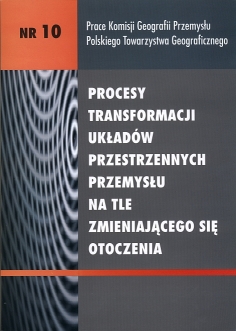Influence of international conditions on oil excavation in the Caspian Sea region
DOI:
https://doi.org/10.24917/20801653.10.12Keywords:
przemysł wydobywczy, ropa naftowa, klaspijskiAbstract
The development of world’s economy and the rise in world’s population are connected with a constantly growing demand for energy. The second half of the 20th century was marked by a particularly rapid increase in exploitation of fuel resources, and by a growth in the role of oil and natural gas in the structure of primary fuels utilization. Nowadays oil covers about 40% of the primary fuels utilization in the world. The richest reserves of oil are located around the Persian Gulf (about 65%). Saudi Arabia, Kuwait, Bahrain, Qatar, the United Arab Emirates, Iran and Iraq provide around 30% of the world’s supply of petroleum. The instability of the region and the threat from the Muslim fundamentalism make the Western European countries and the US search for alternative sources of that fuel. The Caspian region became an area of excellent economic promises. After the collapse of the USSR and the discovery of rich oil reserves in the Caspian Sea bed, the world’s interest in the region grew significantly. The Caspian Sea oil reserves have been estimated for 163 billion barrels, which is around one fourth of the confirmed total Middle East resources.This article presents the problems of different variants of dividing the Caspian Sea, location of oil resources in the region, and the methods and location of its distribution.Downloads
Metrics
References
BP Statistical Review of World Energy, June 2006.
Gulf Publishing Company, „World Oil”, Vol. 227, No. 9 (September 2006).
Janusz-Pawletta B., 2006, Raport: Zasoby Morza Kaspijskiego: Wydobycie i transport do Europy.
Aspekt prawno-międzynarodowy, „Bezpieczeństwo Narodowe”, 1–2006.
Kaspijska ropa i gaz – realia pod koniec roku 2000, 2001, „Prace OSW”, Zeszyt nr 1, Warszawa.
Kazachstan: regionalny przykład sukcesu, Tadżykistan: czas próby, Uzbekistan: najważniejsze źródło niestabilności w Azji Centralnej?, 2004, „Prace OSW”, Zeszyt nr 15, Ośrodek Studiów Wschodnich, Warszawa.
Kłopotliwe bogactwo – sytuacja i perspektywy sektorów ropy i gazu na obszarze byłego ZSRR, 2003, „Prace OSW”, Zeszyt nr 12, Warszawa.
Konflikty zbrojne na obszarze postradzieckim, 2003, „Prace OSW”, Zeszyt nr 9, Warszawa.
PennWell Corporation, „Oil & Gas Journal”, Vol. 104.47 (December 18, 2006).
Raport o światowym rynku energii, 2005, RWE Aktiengesellschaft, Essen, www.rwe.com
Zagórski J., 2005, Aktualia ropy naftowej i gazu ziemnego, „Przegląd Geologiczny”, vol. 53, nr 10/1.
www.peakoil.ie/newsletters
Downloads
Published
How to Cite
Issue
Section
License
Articles are published under the terms of the Creative Commons License (CC BY-ND 4.0; Attribution– NoDerivs).

